Electric and acoustic response are very different. I guess someone here can give a suggestion by simulation in VCAD2.
First try to find datasheets of your drivers, with T/S parameters and axial response graph. Also tell dimensions of the intended baffle and position of the RD in it.
First try to find datasheets of your drivers, with T/S parameters and axial response graph. Also tell dimensions of the intended baffle and position of the RD in it.
My intent is just to make a box/baffle out of what I have in the garage and a box for the woofer somewhere close to the dimensions needed. Since I havn't heard anything like these drivers or an amplifier with power enough I just want something approximately close to try them out.
Cheap box or baffle from old closet doors and cheaper crossover parts.
Cheap box or baffle from old closet doors and cheaper crossover parts.
Alright, send me a message and I will reply back.Everything is for sale at the right price ;-)
That sounds like a good plan. Looking forward to hearing your impressions of them. They are somehow special in my opinion.My intent is just to make a box/baffle out of what I have in the garage and a box for the woofer somewhere close to the dimensions needed. Since I havn't heard anything like these drivers or an amplifier with power enough I just want something approximately close to try them out.
Cheap box or baffle from old closet doors and cheaper crossover parts.
That sounds like a good plan. Looking forward to hearing your impressions of them. They are somehow special in my opinion.
I have parts for some different amplifiers but to get something quick I decided to just make two pairs of LM4780 for a 4-channel amplifier and I got a soundcard from a friend that should enable me to use an old laptop as music source and active filter.
Enough to run some tests.
A question. Teeeters can be damaged if you drive them fullrange without a filter.
Can these be damaged as well?
I would lite to try them out but I have no filters.
Can these be damaged as well?
I would lite to try them out but I have no filters.
Just order a couple of 100uF Capacitors from Conrad.se for now. It's wise to have some caps in there anyway if you are planning on using a DSP for filtering. If you want to be slightly scientific when moving forward swap those out with an MKP capacitor (or a bipolar in parallell with an MKP) that has atleat some (2-3dB) attenuation at fs, since thats were excursion is going to be at it's maximum if things go south.
Yes. Mine were not happy at higher volumes when crossed below 1kHz, but BG says you can cross as low as 150Hz, 4th order. I had no success going that low.A question. Teeeters can be damaged if you drive them fullrange without a filter.
Can these be damaged as well?
I would lite to try them out but I have no filters.
Thanks!Just order a couple of 100uF Capacitors from Conrad.se for now. It's wise to have some caps in there anyway if you are planning on using a DSP for filtering. If you want to be slightly scientific when moving forward swap those out with an MKP capacitor (or a bipolar in parallell with an MKP) that has atleat some (2-3dB) attenuation at fs, since thats were excursion is going to be at it's maximum if things go south.
Hello again.
I have made the decision to crossover at 1000Hz to a pair of 8" 4ohm drivers and I am looking at a 4th order crossover (see attached screenshot).
For the caps I have a bunch of 10uF caps that I'll put in parallell and then add smaller caps to get closer to the specified value.
When it comes to the coils I have a pair of the larger ones of 1.8mH (R=0.49) but also 4pcs of 0.68mH with R=0.71 (0.7mm diameter).
So, the question is regarding the wire thickness of the coils.
The info from BG states that the notch filter should have a coil with a thickness of 1mm.
Does this go for all coils in the crossover or could I use thinner somewhere (the 0.68mH I have at hand)?
Or thicker perhaps?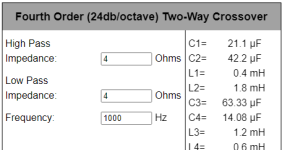
I have made the decision to crossover at 1000Hz to a pair of 8" 4ohm drivers and I am looking at a 4th order crossover (see attached screenshot).
For the caps I have a bunch of 10uF caps that I'll put in parallell and then add smaller caps to get closer to the specified value.
When it comes to the coils I have a pair of the larger ones of 1.8mH (R=0.49) but also 4pcs of 0.68mH with R=0.71 (0.7mm diameter).
So, the question is regarding the wire thickness of the coils.
The info from BG states that the notch filter should have a coil with a thickness of 1mm.
Does this go for all coils in the crossover or could I use thinner somewhere (the 0.68mH I have at hand)?
Or thicker perhaps?

A generic filter of any kind is for the most part not going to give you a very good frequency response. But the further from the drivers own natural roll off the chosen crossover frequency is, the less terrible it will be. 🙂 Use whatever coils you have, but add any series resistance of coils to the driver impedance. But have in mind it´s going to be far from perfect. and because of that, don´t spend time worrying over details, Just get it done the cheapest way possible.
Another thing that WILL affect the filter response are the drivers impedance curves, you can ignore that for now. Just be aware that your filter is going to be suboptimal at best.
This can all be fixed, but the only really good way to get there is to measure the actual summed response of what you have cobbled together and take it from there.
Another thing that WILL affect the filter response are the drivers impedance curves, you can ignore that for now. Just be aware that your filter is going to be suboptimal at best.
This can all be fixed, but the only really good way to get there is to measure the actual summed response of what you have cobbled together and take it from there.
Thanks!A generic filter of any kind is for the most part not going to give you a very good frequency response. But the further from the drivers own natural roll off the chosen crossover frequency is, the less terrible it will be. 🙂 Use whatever coils you have, but add any series resistance of coils to the driver impedance. But have in mind it´s going to be far from perfect. and because of that, don´t spend time worrying over details, Just get it done the cheapest way possible.
Another thing that WILL affect the filter response are the drivers impedance curves, you can ignore that for now. Just be aware that your filter is going to be suboptimal at best.
This can all be fixed, but the only really good way to get there is to measure the actual summed response of what you have cobbled together and take it from there.
Just what I wanted to hear.
Yeah, bring the big wallet.Well I could not take the chance of you destroying them before I get to buy them from you could I?😎
I have a Amazon -65 in the garage that needs new parts 😉
@perrymarshall have a techtalk article using similar big brother 75 inches B&G. Maybe some good info to bring to your 50 inch design?!
Cheers,
Jon
https://www.perrymarshall.com/articles/ultimate2way/
Cheers,
Jon
https://www.perrymarshall.com/articles/ultimate2way/
Perhaps a stupid question but these drivers, when put in a cabinet, do the cabinets need to be air tight like when using regular drivers?
Ok, they are done (for now).
I made them out of readily available 18mm thick pine shelves and even if there are better materials to choose I just wanted something OK and easily assembled to try the drivers out.
The woofers are Omnes Audio W8 alu in a ported 30L box, port is 50mm by 200mm.
Crossover is a 4th order 24db at 1000Hz.
Caps are mostly those russian MBGO-1 10uF@160v and 30uF@160V, evox mmk 1uF@250v and a pair of unknown 10uF polypropylens I got from somewhere a decade or two ago.
Coils are all janzen 1mm air core except for the large, red one, which is a Intertechnik Tritherm.
As they stand, they are just driven by a cheap home theater receiver and a Chromecast. As soon as I get the room in order I'll use them with a dedicated 2-channel setup.
With the amp on mind and the fact that they have had no break-in time they show potential.
I'll probably rebuild the cabinets sometime in the future, if nothing else because they are a bit wobbly.
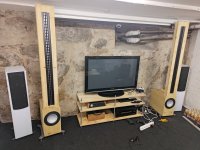
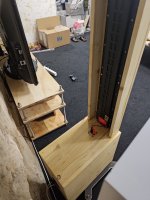
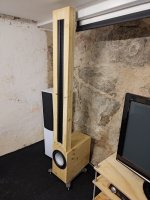
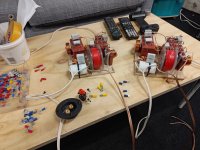
I made them out of readily available 18mm thick pine shelves and even if there are better materials to choose I just wanted something OK and easily assembled to try the drivers out.
The woofers are Omnes Audio W8 alu in a ported 30L box, port is 50mm by 200mm.
Crossover is a 4th order 24db at 1000Hz.
Caps are mostly those russian MBGO-1 10uF@160v and 30uF@160V, evox mmk 1uF@250v and a pair of unknown 10uF polypropylens I got from somewhere a decade or two ago.
Coils are all janzen 1mm air core except for the large, red one, which is a Intertechnik Tritherm.
As they stand, they are just driven by a cheap home theater receiver and a Chromecast. As soon as I get the room in order I'll use them with a dedicated 2-channel setup.
With the amp on mind and the fact that they have had no break-in time they show potential.
I'll probably rebuild the cabinets sometime in the future, if nothing else because they are a bit wobbly.




I'll probably rebuild the cabinets sometime in the future, if nothing else because they are a bit wobbly.
Maybe you can make the top and bottom separable? For example, I have multiple stand-alone top units that will work perfectly on top of that box at 1kHz crossover point, e.g. Heil AMT, Beyer TPL150H AMT, various 1.4" compression driver/horns. Even my 1" Radian compression drivers sounds great at 1kHz if horn is larger.
Maybe you can make the top and bottom separable? For example, I have multiple stand-alone top units that will work perfectly on top of that box at 1kHz crossover point, e.g. Heil AMT, Beyer TPL150H AMT, various 1.4" compression driver/horns. Even my 1" Radian compression drivers sounds great at 1kHz if horn is larger.
Maybe you can make the top and bottom separable? For example, I have multiple stand-alone top units that will work perfectly on top of that box at 1kHz crossover point, e.g. Heil AMT, Beyer TPL150H AMT, various 1.4" compression driver/horns. Even my 1" Radian compression drivers sounds great at 1kHz if horn is larger.
That is one thing I am contemplating. Having the ability to place the top at the side should make it more versatile and if nothing else, more easy to move.
- Home
- Loudspeakers
- Planars & Exotics
- Bohlender Graebener RD50 transducers advice